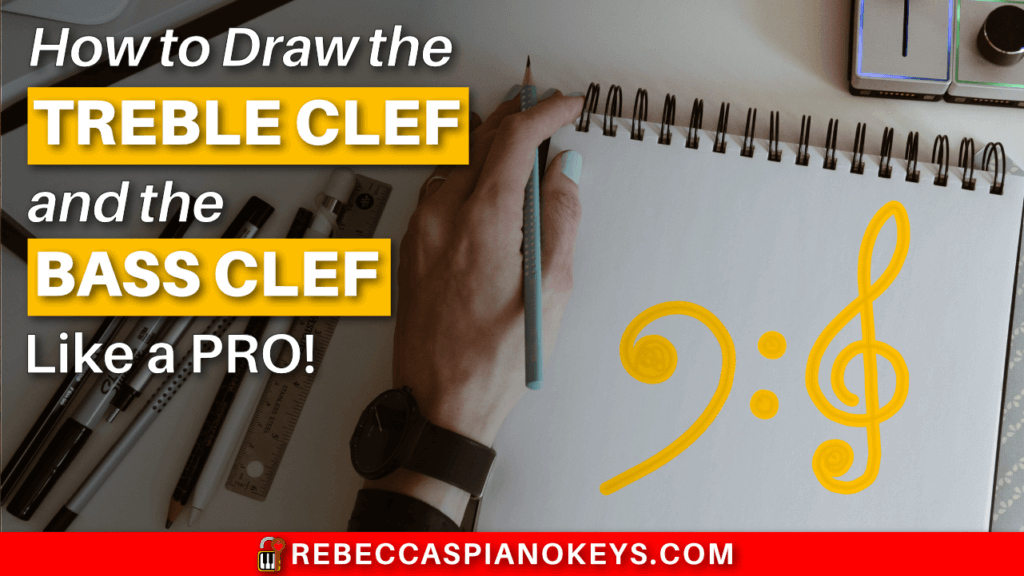Last Updated on June 1, 2022 by Rebecca
If you want to learn how to draw the treble clef and the bass clef, you need to know that different parts of the treble clef and the bass clef actually represent specific notes on the music staff!
Crazy, right?
They aren't just random squiggly lines created arbitrarily to look pretty!
The twists and turns of the treble clef correspond to specific lines on the treble staff.
And the dots in the bass clef all point to a specific note.
Once you learn these landmarks, drawing these 2 clefs will become so easy, you'll wonder why you ever thought it would be so hard!
(Seriously, you'll be doodling treble clefs on everything, like all those 9-year-olds who are always drawing that pointy S symbol everywhere!)

How to Draw a Treble Clef
Did you know that the treble clef is also called the G clef?
Historically, the treble clef was meant to look similar to a letter G. However, as it evolved over time, this semblance has become less obvious.
But why G?
The second line of the treble clef represents treble G. The treble clef was designed to mark this line.
Because the job of the treble clef is to mark the line that represents the note treble G, it's actually easier to start from the inside and work your way out when drawing a treble clef .
Significant points when drawing a treble clef:
- The inside curl marks the G line.
- From there, it wraps up to touch (but not cross!) the B line, then down to touch (but not cross!) the E line.
- Then it loops around and up to the right until about the D line, where it starts curving to the left as it continues up beyond the top of the staff.
- Then it loops left and down down in a straight line and crossing itself at the D line, the B line, and the E line.
- Finally, it extends below the staff then curls up and to the left into a little ball.
It's a lot easier to draw once you realize its twists and turns are all guided by these very specific landmarks!
Check out this video for a detailed tutorial on how to draw the treble clef on the staff:
How to Draw a Bass Clef
Just like the treble clef, the bass clef has another name.
The bass clef is also called the F clef, because it was invented to mark the line that represents bass F: the 4th line of the bass staff (when we refer to lines and spaces by number, we always count from the bottom, no matter which staff we're referring to).
Significant points when drawing the bass clef:
- Start with a large dot (or small coloured-in circle) on the F line. This dot should not come anywhere close to touching any of the other lines near the F line.
- Curl up to touch (but not cross!) the A line.
- Then curl down until just past the B line.
- Then draw 2 large dots, one in the middle of the top space (above the F line), and one in the middle of the third space (below the F line). These dots should be floating right in the middle of the 2 spaces, and should not come close to touching any lines.
The 3 dots in the bass clef are meant to mark the F line. The first dot is directly on the F line, and the other 2 dots are above and below it.
Check out this video for a detailed tutorial on how to draw the bass clef on the staff:
History of the Treble Clef and the Bass Clef
Did you know that historically, the treble clef actually looked like the letter G, and the bass clef actually looked like the letter F?
Calling them the G clef and the bass clef used to be very literal!
The similarity is still there today, but it's a lot less obvious now.
See for yourself in this article about the evolution of the treble clef and the bass clef, by Smithsonian Magazine.


